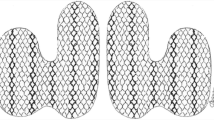Abstract.
Purpose: Treatment of gastroesophageal reflux disease (GERD) in the elderly follows the same principles as for any adult patient. The indication for laparoscopic antireflux surgery (LARS) often depends on the age of the patient. The aim of this prospective study was to evaluate the surgical outcome including quality of life after LARS and laparoscopic “redo-surgery” in patients older than 65 years. Methods: Since 1993, 75 patients with a mean age of 71 years have been treated with laparoscopic “floppy” Nissen (n = 53) or Toupet (n = 22) fundoplication. Thirteen patients underwent laparoscopic redo-surgery after failed LARS. Quality of life (GIQLI) was assessed before surgery and 3 months and 1 year after surgery, with 24-h pH monitoring and esophageal manometry being performed. Results: Intraoperative complications occurred in two patients with primary LARS, successfully managed laparoscopically. The conversion and mortality rate was 0 %. In two patients postoperative complications occurred. Three months and 1 year after surgery 24-h pH monitoring and esophageal manometry showed normal values in all patients. GIQLI increased significantly after surgery and is comparable to that of healthy individuals. One patient suffered from severe dysphagia and required dilatation. In 13 patients who underwent laparoscopic refundoplication, redo procedure was completed laparoscopically in 12 patients. In one patient conversion was necessary because of severe bleeding from the spleen. Data of esophageal manometry and 24-h pH monitoring showed normal values in all patients after redo-surgery. Three months and 1 year after laparoscopic reoperation the general score of GIQLI increased significantly (p < 0.01) and reached a level equivalent to that of comparable healthy individuals. Conclusion: Laparoscopic fundoplication and refundoplication in the elderly patient is a safe and effective treatment in GERD and improves quality of life significantly. Age should not be longer a contraindication to LARS.
Zusammenfassung.
Ziel: Die Indikation zur laparoskopischen Antirefluxchirurgie wird häufig in Abhängigkeit vom Alter des Patienten gestellt und beim älteren Patienten kontrovers diskutiert. Ziel der vorliegenden Arbeit ist die Evaluierung des chirurgischen Outcomes und der Lebensqualität nach laparoskopischer Fundoplicatio respektive Re-Fundoplicatio beim über 65 jährigen Patienten. Methode: Seit 1993 wurde bei insgesamt 75 Patienten im Durchschnittalter von 71 Jahren (range 66–79 Jahre) eine laparoskopische „floppy-Nissen“-Fundoplicatio (n = 53) oder eine laparoskopische Fundoplicatio nach Toupet (n = 22) vorgenommen. Bei 13 weiteren Patienten wurde nach fehlgeschlagener vorausgegangener Antirefluxoperation eine laparoskopische Re-Fundoplicatio durchgeführt. Neben den traditionellen Outcome-Kriterien wurde präoperativ, 3 Monate und 1 Jahr postoperativ die Lebensqualität mit dem Gastrointestinalen Lebensqualitätsindex evaluiert. Ergebnisse: Bei 2 Fällen traten intraoperative Komplikationen (Milzkapselverletzungen) auf, die jedoch laparoskopisch beherrschbar waren. Die Konversions- und Mortalitätsrate war 0 %. Die postoperative Gesamtkomplikationsrate betrug 2,7 %. Die nach 3 Monaten und 1 Jahr postoperativ durchgeführten Kontrolluntersuchungen ergaben für den unteren Oesophagussphincter in der Manometrie und in der 24-Std.-pH-Metrie bei allen Patienten Werte im Normbereich. Der Gastrointestinale Lebensqualitätsindex stieg signifikant von präoperativ 87 Punkten auf 119,1, 119,5 bzw. 119,9 Punkte zu den postoperativen Kontrollterminen an und liegt im Bereich einer vergleichbar gesunden Referenzpopulation. Aufgrund einer postoperativ anhaltenden Dysphagie musste bei einem Patienten eine Dilatation vorgenommen werden. Von 13 weiteren Patienten, die laparoskopisch refundopliziert wurden, konnte der Eingriff in 12 Fällen laparoskopisch beendet werden. Wegen einer laparoskopisch nicht beherrschbaren Milzverletzung musste in einem Fall auf das offene Verfahren umgestiegen werden. Nach laparoskopischer Reoperation lagen die Ergebnisse der postoperativ durchgeführten Manometrie und 24-Std.-pH-Metrie bei allen 13 Patienten im Normbereich. Der GLQI stieg postoperativ signifikant (p < 0,01) an und lag ebenfalls im Bereich einer vergleichbar gesunden Normalpopulation (118,7 Punkte). Schlussfolgerung: Sowohl die laparoskopische Fundoplicatio als auch die laparoskopische Re-Fundoplicatio stellt beim älteren Patienten eine suffiziente und sichere Methode in der Behandlung der gastro-oesophagealen Refluxkrankheit dar und führt zu einer deutlichen Verbesserung der Lebensqualität.
Similar content being viewed by others
Author information
Authors and Affiliations
Rights and permissions
About this article
Cite this article
Granderath, F., Kamolz, T., Schweiger, U. et al. Ergebnisqualität nach laparoskopischer Antirefluxchirurgie: Fundoplicatio und Re-Fundoplicatio beim älteren Patienten. Chirurg 72, 1026–1031 (2001). https://doi.org/10.1007/s001040170068
Issue Date:
DOI: https://doi.org/10.1007/s001040170068




